China
Joint seminar held on rising U.S. investigations of Chinese products involving utility patents
As concerns grow over rising U.S. investigations of Chinese enterprises over utility patents, China’s Ministry of Commerce (MOC) on Tuesday held a seminar with the U.S. International Trade Commission (ITC) to promote mutual understanding on intellectual property protection. “The Chinese government always pays attention to intellectual property protection. However, Chinese enterprises in recent years have become a major target of investigations by the U.S. under Section 337. In particular, thi …
As concerns grow over rising U.S. investigations of Chinese enterprises over utility patents, China’s Ministry of Commerce (MOC) on Tuesday held a seminar with the U.S. International Trade Commission (ITC) to promote mutual understanding on intellectual property protection.
“The Chinese government always pays attention to intellectual property protection. However, Chinese enterprises in recent years have become a major target of investigations by the U.S. under Section 337. In particular, this has been difficult for firms,” said Zhong Shan, China’s vice commerce minister, at the opening ceremony of the seminar.
Section 337 of the U.S. Tariff Act of 1930 allows the U.S. to shield domestic industries from unfair competition, according to ITC judges. Typical violations under the section include infringement of U.S. patents, registered trademarks and copyrights.
China has been the No.1 target for investigations under Section 337 since 2002. In the first 10 months of 2010, there were 16 investigations involving Chinese enterprises, accounting for 42.9 percent of all U.S. investigations under Section 337, said Fu Xiaohui, a senior official from China’s State Intellectual Property Office, at the opening ceremony.
China ranks fifth worldwide in international patent registration, said Fu. In 2009, China had registered 7,946 international patents, up 29.7 percent year on year.
“No one, ITC included, will compensate our losses even if we win these lawsuits one after another, given that it causes us to miss out on business opportunities. Also, there is the cost of responding to these suits. It is unfair,” said Chen Wusheng, a senior economist with the General Protecht Group.
“I think it is a novel type of trade protectionism since it allows U.S. companies to easily apply for 337 investigations,” said Xu Jiali, a lawyer familiar with Section 337.
“I would advise that China set up its own form of Section 337,” Xu added.
Highlighting the independent status of the ITC, James M. Lyons, General Counsel of the ITC, and his colleagues declined to make any direct comments on questions posed by Chen and Xu.
&$&$Source:Xinhua&$&$
See original here:
Joint seminar held on rising U.S. investigations of Chinese products involving utility patents
The restructuring of the economy and resulting efficiency gains have contributed to a more than tenfold increase in GDP since 1978.
China continues to lose arable land because of erosion and economic development.
China has emphasized raising personal income and consumption and introducing new management systems to help increase productivity.
The restructuring of the economy and resulting efficiency gains have contributed to a more than tenfold increase in GDP since 1978.
The two most important sectors of the economy have traditionally been agriculture and industry, which together employ more than 70 percent of the labor force and produce more than 60 percent of GDP.
China has acquired some highly sophisticated production facilities through trade and also has built a number of advanced engineering plants capable of manufacturing an increasing range of sophisticated equipment, including nuclear weapons and satellites, but most of its industrial output still comes from relatively ill-equipped factories.
By the early 1990s these subsidies began to be eliminated, in large part due to China’s admission into the World Trade Organization (WTO) in 2001, which carried with it requirements for further economic liberalization and deregulation.
Globally, foreign investment decreased by almost 40 percent last year amid the financial downturn and is expected to show only marginal growth this year.
“China is now the fifth largest investing nation worldwide, and the largest among the developing nations,” said Shen Danyang, vice-director of the ministry’s press department.
China is expected to have 200 million cars on the road by 2020, increasing pressure on energy security and the environment, government officials said yesterday.
China’s challenge in the early 21st century will be to balance its highly centralized political system with an increasingly decentralized economic system.
Since the late 1970s, China has decollectivized agriculture, yielding tremendous gains in production.
Except for the oasis farming in Xinjiang and Qinghai, some irrigated areas in Inner Mongolia and Gansu, and sheltered valleys in Tibet, agricultural production is restricted to the east.
Hogs and poultry are widely raised in China, furnishing important export staples, such as hog bristles and egg products.
Growing domestic demand beginning in the mid-1990s, however, has forced the nation to import increasing quantities of petroleum.
China is among the world’s four top producers of antimony, magnesium, tin, tungsten, and zinc, and ranks second (after the United States) in the production of salt, sixth in gold, and eighth in lead ore.
Hydroelectric projects exist in provinces served by major rivers where near-surface coal is not abundant.
Coastal cities, especially in the southeast, have benefited greatly from China’s increasingly open trade policies.
Business
Gordonstoun Severs Connections with Business Led by Individual Accused of Espionage for China

Gordonstoun school severed ties with Hampton Group over espionage allegations against chairman Yang Tengbo. He denies involvement and claims to be a victim of political tensions between the UK and China.
Allegations Lead to School’s Decision
Gordonstoun School in Moray has cut ties with Hampton Group International after serious allegations surfaced regarding its chairman, Yang Tengbo, who is accused of being a spy for the Chinese government. Known by the alias "H6," Mr. Tengbo was involved in a deal that aimed to establish five new schools in China affiliated with Gordonstoun. However, the recent allegations compelled the school to terminate their agreement.
Public Denial and Legal Action
In response to the spying claims, Mr. Tengbo publicly revealed his identity, asserting that he has committed no wrongdoing. A close associate of Prince Andrew and a former Gordonstoun student himself, Mr. Tengbo has strenuously denied the accusations, stating that he is a target of the escalating tensions between the UK and China. He has claimed that his mistreatment is politically motivated.
Immigration Challenges and Legal Responses
Yang Tengbo, also known as Chris Yang, has faced additional challenges regarding his immigration status in the UK. After losing an appeal against a ban enacted last year, he reiterated his innocence, condemning media speculation while emphasizing his commitment to clear his name. Gordonstoun, on its part, stated its inability to divulge further details due to legal constraints.
Source : Gordonstoun cuts ties with business chaired by man accused of spying for China
Business
China Dismantles Prominent Uyghur Business Landmark in Xinjiang – Shia Waves

The Chinese government demolished the Rebiya Kadeer Trade Center in Xinjiang, affecting Uyghur culture and commerce, prompting criticism from activists amid concerns over cultural erasure and human rights violations.
Demolition of a Cultural Landmark
The Chinese government recently demolished the Rebiya Kadeer Trade Center in Urumqi, Xinjiang, a vital hub for Uyghur culture and commerce, as reported by VOA. This center, once inhabited by more than 800 predominantly Uyghur-owned businesses, has been deserted since 2009. Authorities forcibly ordered local business owners to vacate the premises before proceeding with the demolition, which took place without any public notice.
Condemnation from Activists
Uyghur rights activists have condemned this demolition, perceiving it as part of China’s broader strategy to undermine Uyghur identity and heritage. The event has sparked heightened international concern regarding China’s policies in Xinjiang, which have been characterized by allegations of mass detentions and cultural suppression, prompting claims of crimes against humanity.
Rebiya Kadeer’s Response
Rebiya Kadeer, the center’s namesake and a notable Uyghur rights advocate, criticized the demolition as a deliberate attempt to erase her legacy. Kadeer, who has been living in exile in the U.S. since her release from imprisonment in 2005, continues to advocate for Uyghur rights. She has expressed that her family members have suffered persecution due to her activism, while the Chinese government has yet to comment on the legal ramifications of the demolition.
Source : China Demolishes Uyghur Business Landmark in Xinjiang – Shia Waves
China
China Expands Nationwide Private Pension Scheme After Two-Year Pilot Program

China’s private pension scheme, previously piloted in 36 cities, will roll out nationwide on December 15, 2024, enabling workers to open tax-deferred accounts. The initiative aims to enhance retirement savings, address aging population challenges, and stimulate financial sector growth.
After a two-year pilot program, China has officially expanded its private pension scheme nationwide. Starting December 15, 2024, workers covered by urban employee basic pension insurance or urban-rural resident basic pension insurance across the country can participate in this supplementary pension scheme. This nationwide rollout represents a significant milestone in China’s efforts to build a comprehensive pension system, addressing the challenges of a rapidly aging population.
On December 12, 2024, the Ministry of Human Resources and Social Security, together with four other departments including the Ministry of Finance, the State Taxation Administration, the Financial Regulatory Administration, and the China Securities Regulatory Commission, announced the nationwide implementation of China’s private pension scheme effective December 15, 2024. The initiative extends eligibility to all workers enrolled in urban employee basic pension insurance or urban-rural resident basic pension insurance.
A notable development is the expansion of tax incentives for private pensions, previously limited to pilot cities, to a national scale. Participants can now enjoy these benefits across China, with government agencies collaborating to ensure seamless implementation and to encourage broad participation through these enhanced incentives.
China first introduced its private pension scheme in November 2022 as a pilot program covering 36 cities and regions, including major hubs like Beijing, Shanghai, Guangzhou, Xi’an, and Chengdu. Under the program, individuals were allowed to open tax-deferred private pension accounts, contributing up to RMB 12,000 (approximately $1,654) annually to invest in a range of retirement products such as bank deposits, mutual funds, commercial pension insurance, and wealth management products.
Read more about China’s private pension pilot program launched two years ago: China Officially Launches New Private Pension Scheme – Who Can Take Part?
The nationwide implementation underscores the Chinese government’s commitment to addressing demographic challenges and promoting economic resilience. By providing tax advantages and expanding access, the scheme aims to incentivize long-term savings and foster greater participation in personal retirement planning.
The reform is expected to catalyze growth in China’s financial and insurance sectors while offering individuals a reliable mechanism to enhance their retirement security.
| This article was first published by China Briefing , which is produced by Dezan Shira & Associates. The firm assists foreign investors throughout Asia from offices across the world, including in in China, Hong Kong, Vietnam, Singapore, and India . Readers may write to info@dezshira.com for more support. |
Read the rest of the original article.






